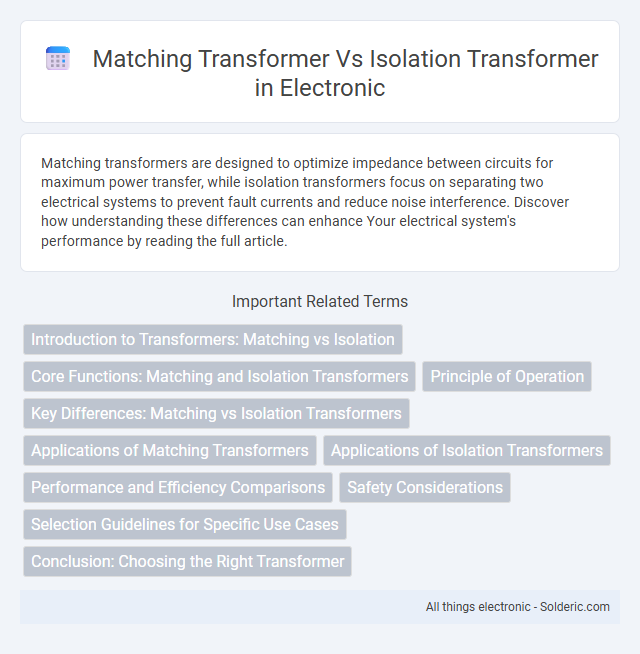Matching transformers are designed to optimize impedance between circuits for maximum power transfer, while isolation transformers focus on separating two electrical systems to prevent fault currents and reduce noise interference. Discover how understanding these differences can enhance Your electrical system's performance by reading the full article.
Comparison Table
| Feature | Matching Transformer | Isolation Transformer |
|---|---|---|
| Primary Purpose | Impedance matching between circuits | Electrical isolation for safety and noise reduction |
| Function | Maximizes power transfer, minimizes signal loss | Blocks DC and transmits AC signals, isolates grounds |
| Typical Application | Audio equipment, RF circuits, antenna matching | Medical devices, power supplies, audio isolation |
| Winding Ratio | Designed to match specific impedance values | Typically 1:1 or close, focusing on isolation |
| Signal Integrity | Maintains signal amplitude and quality | Prevents ground loops and reduces interference |
| Safety | Limited safety isolation | Provides galvanic isolation for user safety |
| Frequency Range | Optimized for specific frequency bands | Broadband or specific ranges depending on design |
Introduction to Transformers: Matching vs Isolation
Matching transformers optimize impedance between electrical circuits to ensure maximum power transfer and minimal signal distortion, commonly used in audio and communication systems. Isolation transformers provide galvanic isolation by separating primary and secondary windings, enhancing safety by preventing ground loops and reducing electrical noise in sensitive equipment. Both types serve distinct roles in electrical systems, with matching transformers focusing on signal integrity and isolation transformers emphasizing safety and noise reduction.
Core Functions: Matching and Isolation Transformers
Matching transformers primarily serve to adapt impedance between circuits, ensuring maximum power transfer and minimizing signal reflection in audio or RF applications. Isolation transformers provide galvanic isolation by separating primary and secondary windings, enhancing safety and reducing electrical noise in power systems. Both transformer types utilize magnetic cores, but matching transformers emphasize impedance matching, while isolation transformers focus on electrical separation and noise reduction.
Principle of Operation
A matching transformer operates by adjusting impedance between circuits to maximize power transfer and minimize signal reflection, relying on precise turns ratio matching within its windings. An isolation transformer functions by magnetically decoupling the input and output circuits, preventing direct electrical connection and enhancing safety through galvanic isolation. Your choice depends on whether impedance matching for signal integrity or electrical isolation for safety and noise reduction is the priority.
Key Differences: Matching vs Isolation Transformers
Matching transformers are designed to optimize impedance matching between devices, improving signal transfer and minimizing power loss in audio and communication systems. Isolation transformers provide galvanic isolation by separating primary and secondary circuits, enhancing safety and reducing electrical noise and interference. Your choice depends on whether you need efficient signal coupling with impedance matching or electrical isolation for protection and noise reduction.
Applications of Matching Transformers
Matching transformers are essential in audio and communication systems to optimize impedance matching between components, ensuring maximum power transfer and signal integrity. They are commonly used in microphone inputs, loudspeakers, and radio frequency circuits to reduce signal loss and noise interference. Your audio equipment benefits from these transformers by delivering clearer sound and improved performance in sensitive signal environments.
Applications of Isolation Transformers
Isolation transformers are widely used in medical equipment to enhance patient safety by preventing electric shock and minimizing electrical noise. They are essential in industrial control systems to isolate sensitive control circuits from high voltage spikes and surges, thereby protecting critical components. These transformers also play a crucial role in data centers by providing clean power supply and reducing electromagnetic interference for reliable server operation.
Performance and Efficiency Comparisons
Matching transformers typically offer higher efficiency by minimizing signal loss and ensuring optimal impedance alignment, which improves overall system performance in audio and RF applications. Isolation transformers prioritize electrical isolation to prevent ground loops and reduce noise but often introduce slightly higher insertion loss and lower efficiency compared to matching transformers. While matching transformers enhance signal integrity and power transfer, isolation transformers excel in safety and noise reduction, impacting their performance metrics differently based on application requirements.
Safety Considerations
Matching transformers primarily ensure voltage compatibility and efficient power transfer, while isolation transformers emphasize electrical isolation to protect your circuits from surges and ground faults. Isolation transformers provide a crucial safety barrier by breaking direct electrical paths, reducing the risk of electric shock and equipment damage in sensitive or industrial environments. Choosing an isolation transformer enhances safety by minimizing electrical noise and preventing unintended current flow, which is essential for maintaining a secure installation.
Selection Guidelines for Specific Use Cases
Matching transformers are ideal for audio equipment where impedance matching is critical to maximize signal transfer and minimize distortion, especially in professional audio or recording studios. Isolation transformers provide galvanic isolation, enhancing safety and noise reduction in power supplies or sensitive electronic devices, making them suitable for medical equipment or industrial applications. Your choice depends on whether signal integrity or electrical isolation is the priority in your specific use case.
Conclusion: Choosing the Right Transformer
Selecting the right transformer depends on your equipment's voltage requirements and load characteristics. Matching transformers are ideal for applications demanding voltage adaptation and impedance matching to optimize performance, while isolation transformers prioritize safety by electrically separating circuits and reducing noise interference. Your choice should balance the need for voltage conversion with isolation to ensure both operational efficiency and protection.
matching transformer vs isolation transformer Infographic

 solderic.com
solderic.com